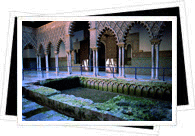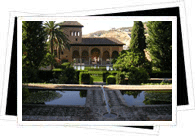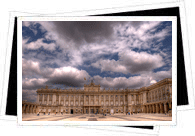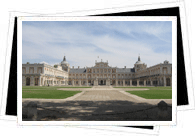 Nothing says royalty quite like having your very own collection of lavish palaces- and that goes for all cultures! Along with the sumptuous Arabic palaces captured along the way during the Reconquest, Spanish royalty had several royal palaces that they commissioned themselves.
Nothing says royalty quite like having your very own collection of lavish palaces- and that goes for all cultures! Along with the sumptuous Arabic palaces captured along the way during the Reconquest, Spanish royalty had several royal palaces that they commissioned themselves.
Arabic palaces presiding from the centuries of Moorish rule are found predominantly in the south, while a handful of royal palaces within the Comunidad de Madrid- a mere stone's throw away from the official capital city-located palace!
Nowadays, these incredible palaces - complete with hundreds of rooms, over the top decoration and acres upon acres of pristine gardens - have been opened up for tourists looking to get an inside look at the life and times of Spain's Christian and Moorish bigwigs. Below you'll find a quick run-down on some of the most important palaces in Spain.
Arabic Palaces:
 La Alhambra
La Alhambra
Granada (Andalucía)
There's no better way to immerse yourself into the romantic, mysterious and exotic world of Spain's historic Islamic culture than with a visit to La Alhambra, Granada's lavish Arabic palace. La Alhambra, along with the Generalife, represents the very pinnacle of Islamic splendor in Spain. Explore the riveting complex of beautiful courtyards, lush gardens, stunning architecture and sumptuous palaces, parts of which date back to the 9th century. A World Heritage site like no other, La Alhambra is Spain's most visited monument- it doesn't take much to see why!
- Reales Alcazares
Sevilla (Andalucía)
Commissioned in the 1360's by the Spanish monarchy after the Reconquest yet built in the alluring Islamic style, this elegant Mudéjar palace was built on top of Moorish ruins. Much like La Alhambra, the intricate palace is an elaborate labyrinth of exotic decoration, beautiful rooms and elegant courtyards. Be sure to check out the immaculate gardens outside, where you can even lost in the maze!
- Palacio de la Aljafería - Aljafería Palace
Zaragoza (Aragón)
With parts dating as far back as the 9th century, Zaragoza's Palacio de la Aljafería is the only surviving example of large-scale Islamic architecture dating back to the epoch of the Taifas (Granada's La Alhambra and Córdoba's La Mezquita were built during posterior epochs). Before it was taken over and inhabited by Aragón's Christian monarchs, this incredible palace was an Islamic fortification.
With the Reconquest, elements of Christian architecture were added on, such as the Renaissance moat and gardens, the Gothic church and the Mudéjar-style addition to the palace. Within is a world of unrivalled beauty, complete with a church, a small mosque, interior courtyards and the graceful, exotic decoration typical of Islamic architecture.
Royal Palaces:
-
 Palacio Real
Palacio Real
Madrid (Comunidad de Madrid)
After Madrid's original fortress burned to the ground one unfortunate winter night, a new Palacio Real (Royal Palace) was commissioned and built entirely of stone. It's impossible to describe the sheer size of the palace in words; just know that Spanish royalty seemed to have quite the affinity for over-the-top constructions fit for - what else - a king.
The palace features 870 windows, 240 balconies and 110 doors, not to mention endless gardens, a royal armory and a lavish interior dripping in decoration. Since the royal family no longer resides in the palace, take the guided tour for a glimpse of the life and times of the high and mighty of Spain's past. Highlights include the sumptuous Throne Room, the massive formal dining room and the Porcelain Room, in which even the walls are decorated with porcelain.
- El Escorial
San Lorenzo de El Escorial (Comunidad de Madrid)
Situated in the mountainous sierras north of Madrid is the mammoth-sized El Escorial. Commissioned in the 16th century by Felipe II, who was looking for a palace where he could enjoy the great outdoors, the palace - technically a palace, monastery and mausoleum - is the largest building in all of Spain.
Built by Renaissance architect Juan de Herrera in his signature ultra-solemn style, the interior features elegant hallways, big-name artwork, lavish living quarters, a jaw-dropping basilica and the Royal Pantheon, where royal family members from the past five centuries are buried in a series of sarcophogi and crypts.
 Palacio Real
Palacio Real
Aranjuez (Comunidad de Madrid)
While it was built as a summer retreat by palace-loving Felipe II, how many summer cottages do you know of that were modeled after France's Versailles? The palace, built in the 16th century, became the favorite of a long line of Spanish royals, each of whom added to or embellished the palace to their liking. The result? Immense, meticulously cared for gardens, majestic architecture and 300 exuberent rooms that will leave you wide-eyed in awe.
 Nothing says royalty quite like having your very own collection of lavish palaces- and that goes for all cultures! Along with the sumptuous Arabic palaces captured along the way during the Reconquest, Spanish royalty had several royal palaces that they commissioned themselves.
Nothing says royalty quite like having your very own collection of lavish palaces- and that goes for all cultures! Along with the sumptuous Arabic palaces captured along the way during the Reconquest, Spanish royalty had several royal palaces that they commissioned themselves.  La Alhambra
La Alhambra Palacio Real
Palacio Real Palacio Real
Palacio Real